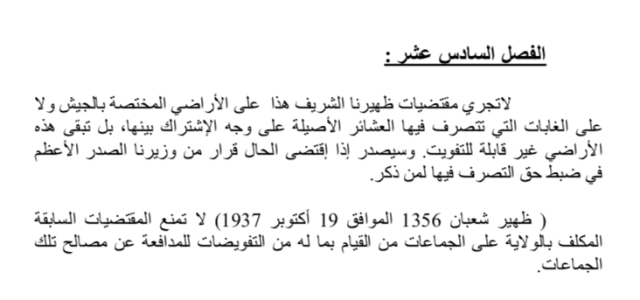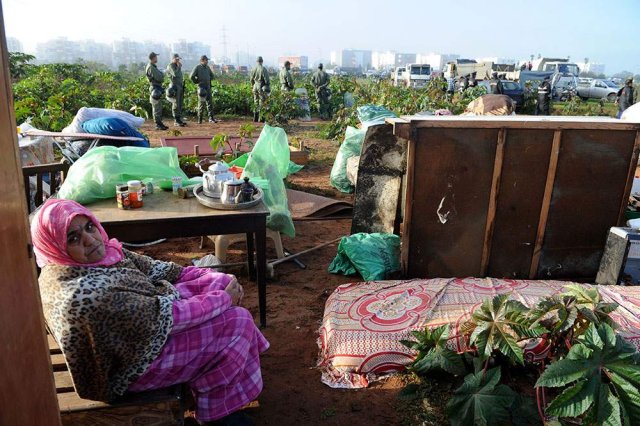73 years ago, Sultan Mohammed V ceded land stretching from the city of Rabat to Temara to warring tribes who fought for the preservation of his reign. In the same year, Bouazza was born.
These warriors are called guich Oudaya, and Bouazza is one of their descendants.
The Oudaya Gulch lands have been titled and registered in the name of the Oudaya Gulch community, which gives them final and unassailable status. However, in defiance of all applicable laws and decrees on the subject, these lands have for several decades been subject to predation in which the administrative, economic and political spheres have been incestuously intertwined, making Bouazza and thousands of other descendants of the guich orphans of their land.
Landless Guich
December 3, 2019. Showers fall on the coastal road between Rabat and Harhoura. A sign suddenly disturbs Bouazza, sitting on the passenger seat of the car. He suddenly turns around and asks us to turn back at the next crossroads. We have just crossed a piece of land that belongs to his community and that he wanted to show us, without being sure that we would be allowed to access it.
On the metal plates covering the construction site, we could read the inscription "IMKAN", a real estate development company subsidiary of the Abu Dhabi Capital Group, owned by an influential Emirati family. The real estate developer has promised to set up, on the same site, its biggest project in Africa, hosting a large 30,000 m2 shopping centre, a 5-star hotel, luxury residences and offices... all built on unjustly confiscated land.
However, the Rabat civil court had issued a final judgment in 2009 ordering an Emirati real estate company named Emaar Safir to suspend its work and leave the premises. According to the ruling, the construction plan for the real estate project included a 5,800 m2 plot of land under land title 22747/R, owned by Guich Oudaya. This decision was handed down at first instance (ATG001) and confirmed on appeal (ATG002).
Same place, ten years later: metal fences surround the site announcing the start of work by the new Emirati developer.
Several kilometres away, the Rafik brothers live with their families in a small two-hectare farm planted with citrus trees. The ravaged soil bears witness to the many wild boar passages that live in the woodlands surrounding their farm. "We live constantly between fear of wild boars ... and harassment by the authorities," says Abdelali, one of the brothers.
And with good reason: his land, located in the Al Boustane area, is the object of the greatest real estate covetousness. In a promotional video published on social networks, the pharaonic project "Rabat City of Light, Capital of Culture" gives indications on the geographical area in which it will be located. Abdelali is categorical: the indications given in the video are consistent with where he lives with other members of his family. He says he lives "under constant threat of forced eviction".
In order to better understand the complexity of the problem, it is worth recalling facts and actions dating back to the beginning of the last century.
Who owns the Oudaya Gish land?
In 1838, the Alawite Sultan Moulay Abderrahmane granted the Gulch lands on the outskirts of the city of Rabat to the Gulch tribe of Oudaya as a reward for their military service to the throne. At the time of the French protectorate, the colonial administration had taken 8.5% of the total area of the Guich lands to make them perimeters of colonization, in application of the 10th article of the Dahir of 27 April 1919 (this article was abrogated after the independence of Morocco, by the Dahir of 6 February 1963). In return for the amputation of these territories, the State granted full ownership of these lands to the communities that had, until then, only a simple right of use (ATG005).
Located on the outskirts of several imperial Moroccan cities, the Guich lands have a special status. Guich Oudaya is one of them. Although they resemble the lands of ethnic communities (soulaliya lands), they are titled in the name of the Oudaya Gish community.
Historically, the Guich Oudaya lands were ceded by the administration of the Cherifian State domain on 10 September 1946 by virtue of a deed of cession in application of the dahir of 19 January 1946, authorizing the concession of a 4,053-hectare state-owned building (this dahir has since disappeared from the archives). According to the terms of this deed of transfer, the Guich Oudaya community obtained ownership of a piece of land that was later registered under number 22747/R (ATG003). This title is a subdivision of the parent title 10053/R (ATG004).
From a legal standpoint, the Oudaya Gich community has a definitive and unassailable right of ownership guaranteed by the registration of these lands. However, the authorities under the Ministry of the Interior intend to exercise a right of guardianship, taking advantage of the dahir of 27 April 1919 (ATG005), which organizes guardianship over collective lands. However, this same dahir clearly excludes, in its Article 16, Guich lands from the scope of guardianship... This truncated reading allows the authorities to dispossess this community of its lands.

Communal lands under guardianship
The dahir of 27 April 1919 marks a turning point in the history of land management of collective lands. Indeed, it organizes the administrative supervision over the communities and regulates the management and disposal of collective property.
Collective lands are owned by the ethnic communities who have a right of usufruct or enjoyment. These lands, although inalienable, are placed under the supervision of the Ministry of the Interior, which exercises its tutelary power through the Directorate of Rural Affairs (DAR), the prefectures or the provinces.
Thus, for the purpose of carrying out projects of public utility, the Ministry may carry out forced expropriation of such land in return for compensation agreed between the State and the supervisory council comprising representatives of the jemaa or ethnic community.
However, article 16 of the dahir of 27 April 1919 stipulates that the provisions of this same text are not applicable to guich lands, nor to forest estates that collective groupings have the use of. This does not prevent the Ministry of the Interior from exercising its supervision over Oudaya Guich lands.
Indeed, and as we have seen in many cases during our research, the Ministry of the Interior, through the Director of the DAR, has transferred ownership of several lots belonging to the mother land title 22747/R in the name of the Guich Oudaya community.
Some other cases of guardianship exercise on Oudaya Gich lands
In 2001, the former Minister of the Interior and current President of the Court of Auditors, Driss Jettou, proceeded with a real estate sale, by decision of the guardianship council dated September 29, 1993, and bearing the seal of the Minister of the Interior under Hassan II Driss Basri, for the benefit of the municipality of Témara. Driss Jettou had presented himself as guardian on the Guich lands. However, the notarial deed dated October 16, 2001 (ATG006) mentions the dahir of April 27, 1919 (ATG005) in the section devoted to the identification of the parties, which, as we saw earlier, stipulates that guardianship cannot be exercised on Guich lands (Article 16).
During this transaction, an area of 50 ha 00 a and 50 ca, parcelling of the mother land title 22.747/R (ATG006) bearing the number 14108/38, property known as "Annasr III" was sold at the price of 25 dirhams per m2.
By decision of the former Minister of the Interior Driss Basri, a plot of land belonging to the Guich Oudaya community with an area of 79,070 m2 forming part of land title 22747/R was acquired by the Skhirate-Témara prefecture (see minutes of the extraordinary meeting (ATG007) at a price of DH25.00/m2 for the benefit of the Hassan II Foundation for the social works of the Ministry of the Interior’s law enforcement officers. These lands were intended for "the realization of operations of allotments or constructions of premises for residential, commercial, professional or administrative uses" according to a notarial deed (ATG008) dated August 18, 1999.
Prior to this sale, the Minister of the Interior had set in motion the mechanism of guardianship over the Guich Oudaya lands, after having issued a decision to divide up the mother land title the same year (ATG008).
On July 1, 1997, exercising his supervision once again over the Guich Oudaya lands, the Minister of the Interior Driss Basri proceeded to the concession of a land of more than 26 hectares to the benefit of the company Sodigec 3, a subsidiary of the ONA group belonging to the royal family, for the construction of the Marjane shopping center. The amount of the annual rent was fixed at the price of MAD 5,000 per year and per hectare for a renewable 18-year period (ATG009).
In 2006, Nour-Eddine Boutayeb, currently Minister Delegate to the Ministry of the Interior, was Director of the Rural Affairs Directorate of the Ministry of the Interior. As a delegate of the then Minister of the Interior, Chakib Benmoussa (who in turn chairs the Special Commission for the New Development Model), he had exercised his supervision over a land belonging to the Guich Oudaya community covering an area of more than 24 hectares located in the middle of Hay Ryad in Rabat for the benefit of the Caisse de dépôt et de gestion (CDG) represented by its Director General Mustapha Bakkoury (currently President of the Casablanca-Settat region).
The sale price was set at 25 dh/m2 (ATG010) on a land whose value is between 8,400 and 13,000 dh/m2 in 2017, according to the price reference of the General Directorate of Taxes.
Incompetence of the Ministry of the Interior on guardianship
A decision of the Administrative Court of Marrakesh of 15 December 1999 annulled the competence of the Ministry of the Interior as the supervisory body for Guich lands, in accordance with article 16 of the Dahir of 27 April 1919, which excludes Guich lands from the supervision of the Ministry of the Interior.
The court ruled in favour of a member of the Guich Fnida Ait Ayyad against the Ministry of the Interior represented by the Directorate of Rural Affairs (ATG011). Already in 1979, the administrative chamber within the Court of Cassation in administrative file No. 451913 had decided that the Ministry of the Interior was not competent as a supervisory body for Guich lands (ATG012).
Compensation to beneficiaries or land predation?
After several splits of land title 22747/R, and at the end of a meeting held on 25 November 2012 of the customary assembly of the Guich Oudaya community (whose representativeness is contested by many claimants), a proposal was decided on setting compensation of 650 dirhams per square metre on Guich Oudaya land (ATG013). Abdelali Rafik, a member of the Guich Oudaya community, witnessed several attempts by the authorities to negotiate his eviction in return for this sum per square metre.
However, in the course of our research, we were able to note that agents of the Ministry of the Interior, notably under the Directorate of Rural Affairs (which claims to exercise guardianship on behalf of the Ministry of the Interior) but also officials of the Wilaya of Rabat, were able to obtain plots of land located on land belonging to the Oudaya guich community, ranging in size from 225 to 306 m2 , located in Témara, without our being able to determine whether these plots of land were obtained free of charge or at preferential prices (ATG014).
Does securitisation make it possible to guarantee the right to collective private property?
The cases mentioned above are far from exhaustive. Despite the existence of clear legal texts on the issue of guardianship over collective land and the exception affecting Guich land, the Moroccan authorities are seeking to reclassify the status of Guich land as collective land, in order to allow the exercise of guardianship by the Ministry of the Interior.
In other cases, influential foreign real estate development lobbies have not hesitated to seize land registered in the name of the Oudaya Gich community, in flagrant disregard of court decisions.
The confiscated Guich Oudaya lands are in many cases used for private commercial real estate projects.
State officials and civil servants are, as has been noted, among the beneficiaries of the fragmented land base of Guich Oudaya. Moreover, a recent scandal dating from 2016, known as the "land of the servants of the State", has shown the extent of political predation on land. Influential political figures, including the ministers of the Interior and Finance, the king’s advisers, etc. were allocated plots of land at the price of 350 DH/m2 instead of the real value of 25,000 dh (source: lakome2). A few days after this scandal, the online platform of the Land Registry service was deactivated, before being reactivated a few months later with restrictions on access to the registers. Indeed, whether online or physically, information on land titles can only be communicated to persons authorised by law, or to the owners or agents of the said titles.
This measure, which enshrines opacity at the expense of transparency, worryingly restricts freedom of access to information, and a fortiori threatens the right to individual or collective ownership of land.
Witnessing the collapse of the land of these ancestors, now in their seventies, Bouazza follows with great concern the transformation that this political and financial predation is causing: "All these new projects in Hay Riad are intended for the wealthy. As for us, the modest people, we are banned. You can see for yourself, there are no new public schools or hospitals being created on these lands."




